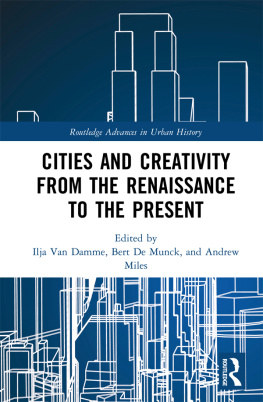Creative Economy and Culture
Challenges, Changes and Futures for the Creative Industries
- John Hartley
- Wen Wen
- Henry Siling Li
SAGE Publications Ltd
1 Olivers Yard
55 City Road
London EC1Y 1SP
SAGE Publications Inc.
2455 Teller Road
Thousand Oaks, California 91320
SAGE Publications India Pvt Ltd
B 1/I 1 Mohan Cooperative Industrial Area
Mathura Road
New Delhi 110 044
SAGE Publications Asia-Pacific Pte Ltd
3 Church Street
#10-04 Samsung Hub
Singapore 049483
John Hartley, Wen Wen and Henry Siling Li 2015
First published 2015
Apart from any fair dealing for the purposes of research or private study, or criticism or review, as permitted under the Copyright, Designs and Patents Act, 1988, this publication may be reproduced, stored or transmitted in any form, or by any means, only with the prior permission in writing of the publishers, or in the case of reprographic reproduction, in accordance with the terms of licences issued by the Copyright Licensing Agency. Enquiries concerning reproduction outside those terms should be sent to the publishers.
Library of Congress Control Number: 2015937418
British Library Cataloguing in Publication data
A catalogue record for this book is available from the British Library
ISBN 978-0-85702-877-8
ISBN 978-0-85702-878-5 (pbk)
Editor: Chris Rojek
Assistant editor: Gemma Shields
Production editor: Katherine Haw
Marketing manager: Michael Ainsley
Cover design: Shaun Mercier
Typeset by: C&M Digitals (P) Ltd, Chennai, India
Printed in India at Replika Press Pvt Ltd
Frontispiece: Global Media Culture.
The Shakespeare Duck: Globe Theatre Shop, London.
About The Authors
John HARTLEYJohn Hartley, AM (Order of Australia), is John Curtin Distinguished Professor at Curtin University Australia, and Professor of Journalism, Media and Cultural Studies at Cardiff University Wales. Recent books include:
Cultural Science: A Natural History of Stories, Demes, Knowledge and Innovation (with Jason Potts, Bloomsbury, 2014);
Key Concepts in Creative Industries (co-authored, Sage, 2013);
A Companion to New Media Dynamics (co-edited, Wiley-Blackwell, 2013); and
Digital Futures for Cultural and Media Studies (Wiley-Blackwell, 2012). He is editor of the
International Journal of Cultural Studies (Sage) and publisher of
Cultural Science Journal (online). He is a Fellow of the Australian Academy of Humanities and the International Communication Association, Honorary Professor of Zhejiang University of Media and Communications (Hangzhou), and Guest Researcher, Institute for Cultural Industries, Shenzhen University, China.WEN WenWen received her doctoral degree in creative industries from Queensland University of Technology, Brisbane, Australia in 2012. She is now a Lecturer and Director of the Project Development Department of the Shenzhen Institute for Cultural Industries, University (SZU), China. She was a visiting scholar at Curtin University, Australia in 2014 (February to April). Her main research interests include creative scenes, urban culture and the cultural economy. She has published academic papers in the
International Journal of Cultural Studies,
International Journal of Cultural and Creative Industries and
Cultural Science Journal.Henry Siling LIHenry is Senior Lecturer and Director of International at the School of Media, Culture and Creative Arts in the Faculty of Humanities, Curtin University. He has a PhD in creative industries from Queensland University of Technology and MA in simultaneous interpreting from Beijing Foreign Studies University. Henry worked at China Executive Leadership Academy Pudong for ten years and was Executive Director of its Centre for International Courses and Programs before joining Curtin University in 2013. His research covers social media, user productivity and young people in China and has been published in the
Chinese Journal of Communication and
Cultural Science Journal.Economy + Culture + Technology = Newness
How can a system develop and yet remain true to itself?
(Yuri Lotman, 2009: 1)
Whose creative industries?
The question is: Whose creative industries? We need to ask it, because much of the discussion about the creative industries or creative economy (also called the cultural industries), in policy, scholarly and industry circles, presumes quite limited answers to that question. Thus, the standard answers are: Creative industries describes a specialist sector of the economy; only certain types of work or occupations count as creative; not many countries can boast a creative economy. A presumption has taken hold that creative industries refers to the copyright industries, whose business plan is founded on making the creative outputs of talented individuals into intellectual property, and then selling that.
We dont think any of these are satisfactory answers. In this book, we want to pose the question anew, by making the answers as broad and inclusive as is possible. Here, the answers which we call the three bigs are:
- The creative industries are not confined to an elite of trained artists or firms; they encompass (or could encompass) everyone.
- They are not confined to one sector of the economy; they characterise (or could characterise) everything.
- They are not a feature of advanced or wealthy countries; they are (or could be) everywhere.
The difference between are and could in the formulations above is not meant to be normative, but rather to describe a situation where we would argue a more expansive answer is possible, but unnoticed or even unknowable using current approaches. Thus, posing the question Whose creative industries? is to some extent a thought experiment, because quite clearly this expansive conceptualisation of the role of creativity in contemporary cultures and economies is not in place as an everyday reality, nor is it part of everyday talk among those who comprise the conceptual community or discourse public of the creative industries, whether they are scholars, policymakers, consultants or industry insiders. Therefore, the overall purpose of this book is to develop a coherent perspective and an argument that will put these answers on the table, so to speak, as an alternative to current conceptual settings. We are not so much arguing that the creative economy and culture
















